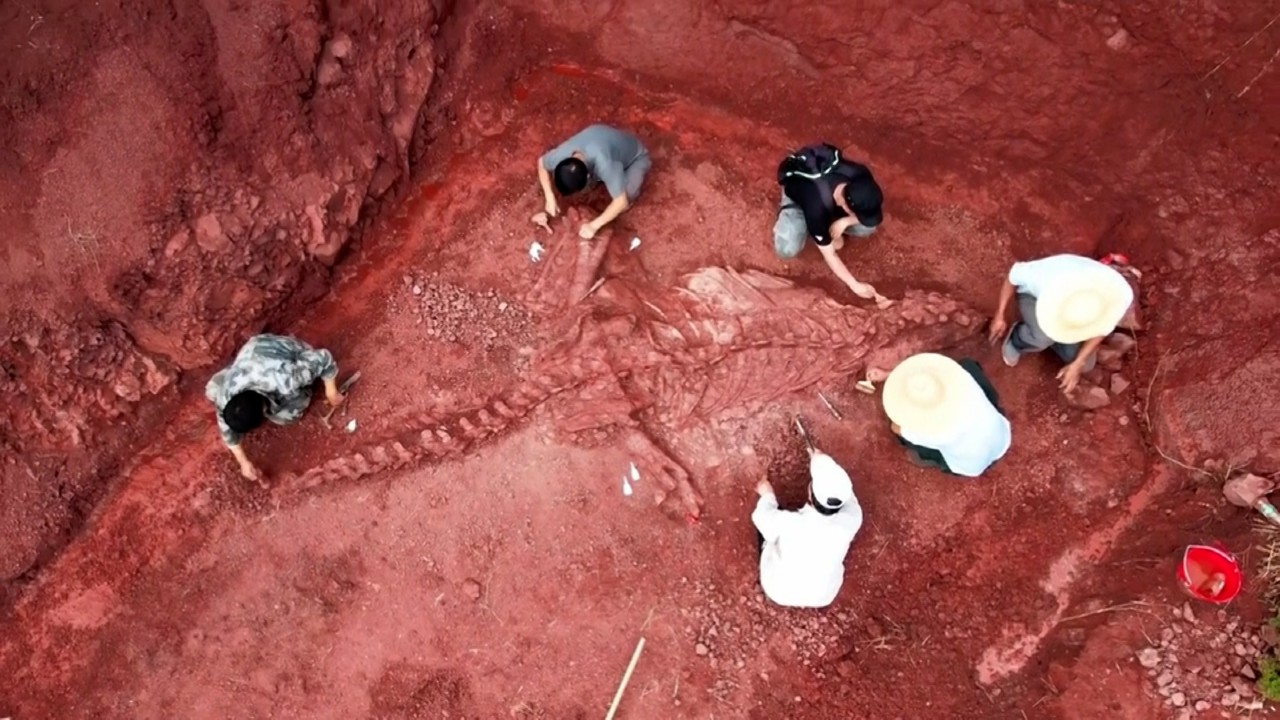
‘Baby Yingliang’: unborn dinosaur’s position inside Chinese egg fossil strengthens link with birds, say scientists
- Rare 66-72 million year-old embryo had its head below its body, feet on either side and back curled in a pose not previously recognised in non-avian dinosaurs
- Egg was acquired in 2000 and kept in storage for a decade before being brought to light again during the building of the Yingliang Stone Natural History Museum
The rare embryo, housed at the Yingliang Stone Natural History Museum and referred to by researchers as “Baby Yingliang”, dates back to 66-72 million years ago. It was revealed to have its head lying below its body with its feet on either side and back curled along the blunt end of the egg. This position has not previously been recognised in non-avian dinosaurs and was similar to that of a late-stage modern bird embryo, the study team from Britain, Canada and China said.

The scientists said the discovery raised the possibility that avian pre-hatching behaviour might have originated in non-avian theropods during the Cretaceous period and that it could be further investigated in embryo fossils belonging to other dinosaurs.
“This new exceptional fossil embryo hints that some early developmental behaviours, [namely] tucking, often considered as uniquely avian, may be rooted more deeply in the theropod lineage, as has already been observed with other features of reproduction [such as] parent dinosaurs incubating nests of eggs,” the team wrote in an article published the peer-reviewed journal iScience on Wednesday.
Joint first author and PhD researcher at the University of Birmingham Fion Ma Wai-sum told the South China Morning Post the discovery was more evidence that today’s birds evolved from theropod dinosaurs.
“We found that this dinosaur embryo has a very similar posture to today’s birds, like chickens, when they are about to hatch,” she said. “We believe the dinosaur would have hatched in a way very similar to birds.”
Dinosaur eggs unearthed in Chinese city with history of the giant reptiles
She said the dinosaur baby roughly corresponded to a 17-day-old chicken embryo, which would hatch on day 21. Bird embryos bend their body and bring their head under their wing soon before hatching to stabilise the head and make it easier to break the eggshell, she said.
Ma said seeing the embryos was an exceptional opportunity for scientists.
“I was very surprised when I first saw the photo of the egg. We know dinosaur embryos are rare fossils and it is very precious to have it so well-preserved,” she said.
“Fossilised embryos unearthed in the past were not intact and they might only show a few bones. Scientists could hardly tell its posture in the egg.”

The embryo in a fossilised egg was recovered in the Hekou Formation, a geological formation that has preserved dinosaur bones and eggs as well as fossilised plants, in the city of Ganzhou in the eastern Chinese province of Jiangxi, according to the study.
The elongated egg was about 17cm (6.7 inches) long, and the skeleton was an estimated 27cm from head to tail. It occupied nearly the entire width of the egg and most of the length, the team found.
The dinosaur could have been 2-3 metres (6.5-10 feet) long when it reached full adult size, Ma said.
The researchers observed a 2cm space between the prenatal dinosaur and the egg. They said it might represent the air cell – usually found in bird eggs between the back of the embryo and the blunt pole of the egg – although they needed more evidence to prove it.
The team said the embryo was likely to be in its late stage of development “because the skeleton is well ossified and is large in size relative to the space inside the egg”.
The egg was acquired in 2000 and kept in storage for about 10 years before being brought to light again during the building of the Yingliang Stone Natural History Museum in the coastal city of Xiamen in southeastern Fujian province, said Xing Lida, joint lead author and associate professor at China University of Geosciences in Beijing.
“Museum staff identified them as dinosaur eggs and saw some bones on the broken cross section of one of the eggs,” Xing said. Then the fossils were prepared, unveiling the embryo hidden inside the egg.
Ma with the University of Birmingham said the researchers would continue to study the rare specimen, including using X-rays to take images of its internal anatomy, such as skull bones and other body parts still covered in rocks.
Did Jurassic World raptors once roam in packs across China?
Based on its deep, toothless skull, the team identified the baby as a toothless theropod dinosaur, or oviraptorosaur.
The team said oviraptorosaurs – or “egg thief lizards” – were theropod dinosaurs with feathers that were closely related to modern-day birds and known to be from the Cretaceous period in Asia and North America.
They were likely to have adopted a wide range of diets, from herbivory to omnivory and carnivory, thanks to their different beak shapes and body sizes, the team said.


